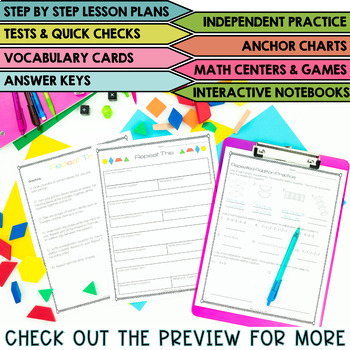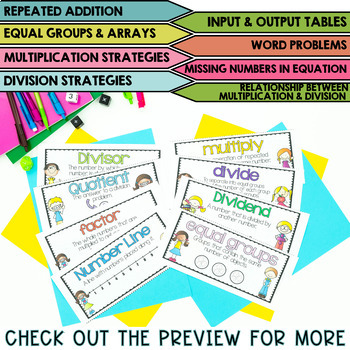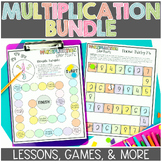Multiplication and Division Activities | Worksheets | Lessons | Guided Math Unit
- PDF
- Google Apps™

What educators are saying
Also included in
- I've created this BUNDLE with the Multiplication and Division Math Workshop Unit and the Multiplication Shortcuts Math Workshop Unit. It's the exact resource you've been looking for to add to your workshop and to help your students grow their multiplication skills!**Save 20% by purchasing the bundlePrice $19.20Original Price $24.00Save $4.80
- Your students have gaps in their math instruction but you have to teach the grade-level standards. How can you get them on grade-level without teaching math all day long?These guided math workshop units cover all of the important math concepts in-depth to make your math instruction effective, your sPrice $75.60Original Price $108.00Save $32.40
Description
Challenge your students in math workshop like never before! This is a unit plan designed to teach multiplication and division, and I guarantee that your planning will be made easier with the help of this resource! What's more is that your students will have FUN while they learn!
Save 20% when you buy the 3rd Grade Math Workshop for the ENTIRE Year BUNDLE! It has everything you need for the entire school year in math, including this unit!
***This product is also located in my Multiplication Math Workshop BUNDLE! You can save 20% when you buy the bundle!***
Check out the preview for details!
This Unit Covers:
- The multiplication strategies of equal groups, arrays, repeated addition, and skip counting using number lines.
- Understanding the relationship between multiplication and division through fact families and inverse operations.
- The division strategies of equal sharing and repeated subtraction.
- What remainders are.
- How to use inverse operations to solve problems with missing numbers in the equation.
- Solving and creating multiplication and division word problems.
- Finding patterns and completing input and output tables.
With This Unit You'll Get:
- Detailed and thorough lesson plans
- Vocabulary cards that can be used for a word wall
- Anchor charts
- Detailed mini-lessons, along with the resources necessary to carry them out (games, worksheets, anchor charts, and other printables)
- Activities for remediation and enrichment
- Choices as to how you would like to implement the lessons
- Three reviews (one for multiplication, one for division, one overall)
- Answer keys
- Independent time activities
- Pre-tests and Post-Tests
- Color and B/W Versions
- Printable & Digital Versions
Other Related Products You May Enjoy:
Free Multiplication & Division Unit Sampler for Math Workshop
Multiplication Facts Shortcuts: Identifying Strategies and Patterns
3rd Grade Problem Solving Unit for Math Workshop
**IMPORTANT NOTICE**
This resource is not editable. I cannot allow the resource to be editable due to the Terms of Use on the clip art used, including in the digital version. The lesson plans ONLY are editable BUT ONLY in the full year bundle.
Printing Notes:
While I recommend printing in color and laminating materials for future use, it is not necessary. These materials print just fine in grayscale. I would suggest printing "as image" to avoid any potential issues.
☞Mistakes Happen!☜
If you see ANYTHING that needs modifying, or if you have any questions, please contact me via the Q&A. I take my product creation and your satisfaction very seriously! Thanks!
⭐Earn FREE Resources! ⭐
It's very important to me that you provide feedback so that I may improve and create products you will use and love! Please consider leaving detailed feedback. Additionally, each time you provide feedback, you earn TpT credits. These can be taken off purchases so you can get items free!
❤️Love What You See? ❤️
Join my email list here to get FREEBIES and so much more!
Follow my store here to get discounted goodies each time they're posted!







